Have you ever taken a bite of your favorite salad or entree and thought, “Wow, this is so zesty!” But then you wondered, does zesty actually mean spicy?
It’s a common question, since we often use “zesty” and “spicy” interchangeably when describing flavorful dishes. However, while related, zesty and spicy refer to two distinct tastes.
In this article, we’ll explore the differences between zesty and spicy foods. You’ll learn:
- The definitions of both zesty and spicy – Zesty has a bold, tangy taste while spicy contains spices or chilies for a hot, burning flavor.
- Key differences in how they impact flavor – Zesty seasons and spikes existing flavors while spicy embellishes by enhancing aroma and appearance.
- What ingredients create zest versus
spice – Zest comes from citrus fruits, like lemons and limes, whilespice comes from peppers, herbs, and other seasonings. - How to add zing or heat to your recipes – Use specific tools and techniques to create the perfect zest or
spice blend. - Which foods pair best with each flavor – Zesty flavors like citrus complement vegetables, fish, and vinaigrettes while spices enhance meats, curries, and chocolate.
Let’s dig in and solve the mysteries of zesty versus spicy!
Defining Zesty and Spicy: It’s Not Interchangeable
First, what exactly do we mean when describing flavors as “zesty” or “spicy”?
Zesty foods have a bold, tangy taste that awakens your taste buds. Zestiness comes from citrus fruits or tart herbs and adds vibrancy.
Spicy foods contain spices or chilies that give them a hot, burning, or piquant flavor. Different spices create unique heating effects.
So while both zesty and spicy foods are highly seasoned, zestiness focuses on tart, bright tastes while spices bring the heat. You wouldn’t want to mix them up!
Key Differences Between Zesty and Spicy
Beyond definitions, zesty and spicy impact food in different ways. Keep these key distinctions in mind:
- Zesty seasons and spikes flavors while spicy embellishes and enhances aroma or appearance.
- Zest comes from citrus fruits, like lemon, lime, or orange. Spicy comes from peppers, spices, herbs, etc.
- Zesty has a tangy, tart taste while spicy brings a burning, searing sensation.
- Zesty livens up flavors already present while spicy can introduce entirely new dimensions.
So a zesty salad dressing brightens the flavors of greens and vegetables. But a spicy curry sauce or Mexican mole adds smoky, sweet, and savory complexity.
Understanding the nuances helps ensure you get the right balance of flavors.
Creating Zest: Citrus Peels Are the Secret
Now that you know zesty ≠ spicy, let’s explore what exactly creates zestiness.
Surprisingly, the secret ingredient is citrus peels!
Best Fruits for Zesting
The outer rind of citrus fruits contains flavorful, aromatic oils. When you zest, you’re grating off just this flavor-packed outer peel.
These fruits make the best candidates for zesting:
- Lemons: Tart and bright
- Limes: Zingy, almost herbal flavor
- Oranges: Mild and a little sweet
You can experiment with other citrus like grapefruit, yuzu, Meyer lemons, etc. But standard lemons, limes, and oranges offer the most versatility.
Tools You’ll Need for Zesting
While you can use standard graters, a microplane zester makes the process easier and faster. The ultra-sharp teeth remove only the outermost peel.
The Microplane Premium Classic Zester is my top pick. The stainless steel blade quickly zests without digging into bitter pith.
You can also try an OXO Good Grips Box Grater with handy zesting attachment. The sharp etched surfaces work for dry cheeses, chocolate, etc. too.
How to Zest like a Pro
Follow these simple steps for the perfect zest every time:
- Wash fruit thoroughly. Remove any stickers or wax.
- Trim away the nubby ends, which can obstruct zesting.
- Hold fruit in one hand, microplane upside down in the other.
- Grate by stroking from top to bottom, rotating as you go.
- Stop when you see white pith; zest will collect in microplane.
- Add zest to your recipe or store in an airtight container.
Pro tips: Go light on pressure, avoid pith, and work over a bowl to catch every flavorful bit!
Adding Spice : The Many Faces of Heat
While zest relies on citrus, spices open up a whole world of heating possibilities. Let’s look at popular spices, DIY blends, and how to
Types of Spices for Heat
From sweet to smoky, different spices create unique flavors and sensations. Popular spicy options include:
- Chili peppers: Range from mild to scorching hot. Try jalapeño, habanero, cayenne.
- Paprika: Adds warmth and beautiful color. Smoky Spanish paprika is especially nice.
- Ginger: Imparts a vibrant, peppery kick and pairs well with citrus.
- Cinnamon: Warm and slightly spicy but also sweet.
- Cumin: Earthy, nutty flavor with a touch of heat. Works well in chili.
- Curry powder: Varies by region but typically contains coriander, turmeric, fenugreek, chili.
Mix and match to create the exact
DIY Spice Blends
With a few key tools, you can easily make custom
You’ll need:
- Clean jars or tins for storing
spice mixes - Measuring spoons and cups
- A coffee or
spice grinder, like the COSORI Electric Grinder
Then simply:
- Measure out ingredients in your preferred ratios.
- Mix together thoroughly.
- Grind into a fine powder.
- Funnel into jars, label, and store.
Adjust amounts until you’ve created your go-to
Spicing Up Any Dish
Spices complement both savory and sweet recipes:
- Meats: Chili, curry powder, cumin, paprika, cayenne
- Vegetables: Curry, red pepper flakes, chili powder
- Rice dishes: Turmeric, saffron, ginger, cumin
- Chocolate: Cayenne, cinnamon, espresso
- Fruits: Cinnamon, ginger, nutmeg, cloves
Start with a pinch or dash and add more heat gradually. You can always
Zesty and Spicy: Enhancing Foods in Different Ways
Now that you’re armed with the knowledge, let’s recap how zesty and spicy work hand in hand to make food burst with flavor.
- Zesty awakens existing flavors with tangy citrus zest. It adds vibrancy and makes tastes “pop.”
- Spicy introduces new dimensions like heat, smoke, earthiness with spices and chilies. It enhances aroma and visual appeal.
While zesty and spicy both season and amplify dishes, they work in different ways.
Use zesty citrus flavors to complement without overpowering the core ingredients. And turn to spices when you want to add intrigue, complexity, and kick.
Once you know the building blocks, it’s easy to create well-balanced dishes that pop with flavors.
So go ahead, make your salads zesty and your curries spicy. Just don’t confuse the two!
Now that your taste buds are ready for an adventure, it’s time to start cooking up zesty, spicy creations.
What flavors will you try first? Let us know how you like to use zest or





